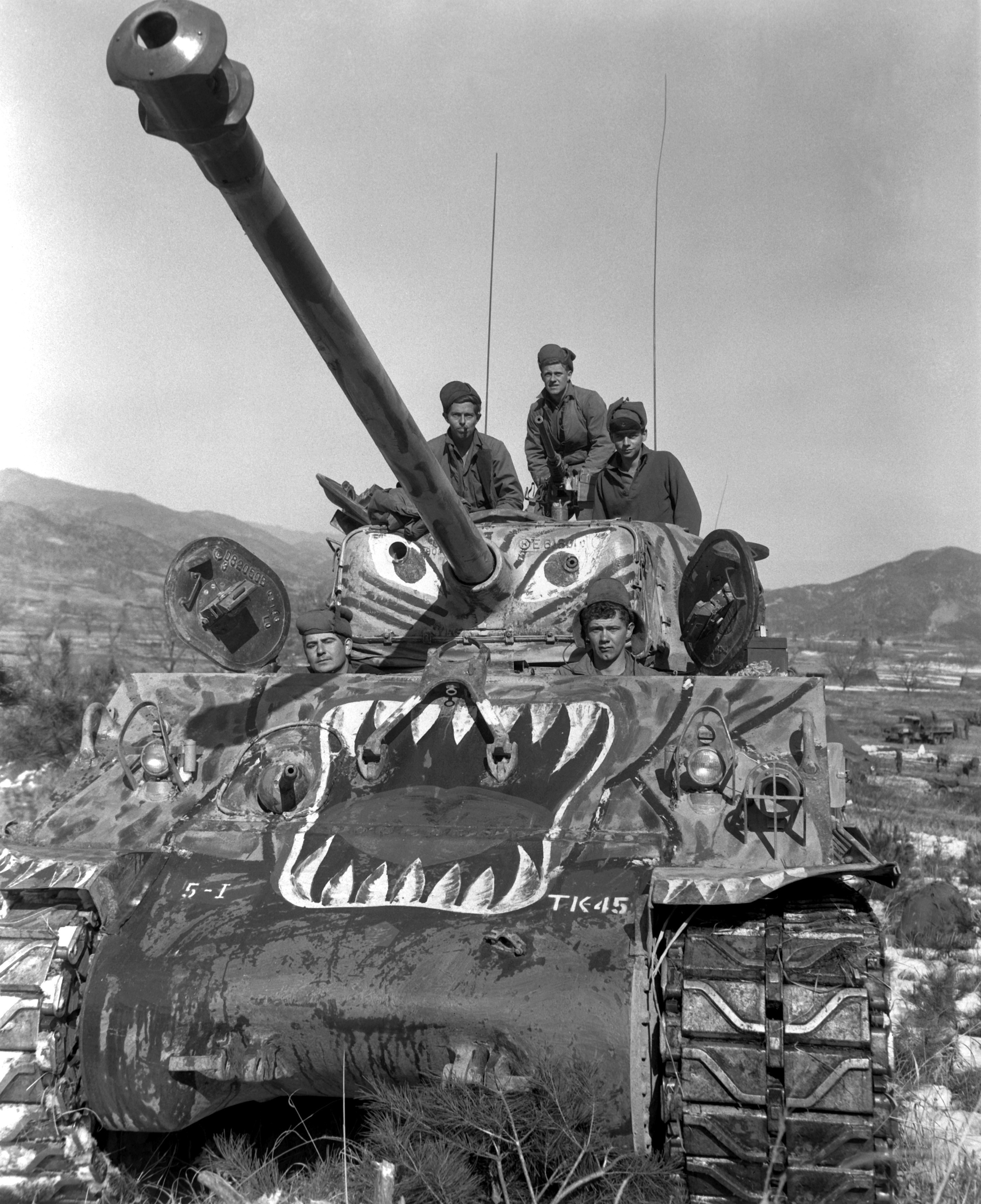It was seventy years ago today that the US Army selected the “T6 Medium Tank” for production as the standard “medium” tank for the United States Army.

The T6 - the first of over 50,000 "Sherman" tanks.
The process of standardization led to the Army’s procurement bureaucracy to give it an “M” designation- “M4”, in this case. The Army’s public relations bureaucracy also supplied the tank a name – a custom that had started with British usage the previous summer in the Western Desert, where they named US-built M3 Light tanks the “General Stuart”, after the Civil-War-era Confederate cavalryman, a bit of PR to win American hearts and minds to the British cause that came, at least in part, from Winston Churchill’s desk.
They chose “General Sherman”.
And so the vehicle that would serve as the standard tank for the US Army and Marine Corps – and the British, Canadian, Free French, Free Polish, Indian, Nationalist Chinese and part of the Soviet armies – throughout World War 2 and into the Korean Conflict, entered the American lexicon.
And it showed, literally and figuratively, some of the nagging weaknesses as well as overwhelming strengths of the American war effort for the war that, for the US, was still eight months away.
To call something as tough, as subtle, as powerful or as nuanced “as a Sherman tank” is a metaphor that’s passing from common American usage, as the generation that drove them or grew up with those who did drive them ages out of the prime simile-generating years – but for the first forty-odd years after World War 2, the metaphor was pretty well understood.
And a little misplaced.
Designing any military vehicle, from a ship to a jeep to a fighter jet, is a matter of reconciling three key mutually-exclusive factors; mobility, firepower and survivability (at any given technological level), along with some minor factors (cargo space, habitability, ease of maintenance and so on). For example – it’s a simple matter to build a tank that can go 80mph. But can it carry a gun? Or enough armor to make it survive a hit from an enemy tank? And can you imagine the maintenance nightmares taking care of the engine and suspension capable of that kind of performance?
Likewise, it’s theoretically easy to build a tank that can’t be killed – build a thick armored shell! But can it actually move in such a manner as to threaten the enemy? If not, you have basically a semi-mobile bunker. And if it can move, how big will it have to be to hold a powerful-enough engine, plus the fuel, plus the crew – and some kind of weapon to boot?
The Sherman was a reflection of how that compromise was made in the US in 1941 , and of a vision that, arguably, went very very wrong.
The United States Army was, arguably, one of the most conservative armies in the world by the 1930’s. Since the Civil War, its primary experience had been fighting Indian tribes and Philipino insurgents and,briefly, the Spanish and for about a year and a half, a frantic bout of modern industralized war in France during World War I.
When the tank was invented in the last few years of World War I, it was a revolutionary bit of technology, dropped into the most conservative institutions on earth – the world’s various militaries, most of which had absorbed a century’s worth of technological change since 1815 but which in terms of organization and tactical doctrine were not that much different in 1914, or even 1918, than they’d been at Waterloo in 1815. Every army, in 1920 as in 1815, had three branches; Infantry, Cavalry and Artillery. Thus it had always been. And most of the world’s armies, being conservative, tried to fit the new technology of the tank into the old idiom of the three-branch Army.
And so by the mid-thirties, most armies built two types of tanks; the slow, well-armored “Infantry Tank”, designed to accompany and support troops as they advanced at the speed of the human leg; tanks like the French Char B and British Matilda…

The French Char B

The British Matilda tank, fighting in Libya 70 years ago
…and variations on the “Cavalry Tank” – fast, lightly armed and armored, built to do what the horse cavalry had always done, scouting and raiding and, when the infantry and tanks blasted a hole in the enemy’s front line, dashing through and wreaking havoc among the enemy’s headquarters and supply lines – tanks like the British Mark VI and the French Somua…

British Mark VI Tank

French Somua Cavalry tank - arguably the best tank in the world in 1940 although plagued with the same sort of mechanical trouble that plague all French automotive products to this day.
The United States did the same – indeed, due to the deep divisions between branches, the Army decreed that in the United States, a “tank” served the infantry, and the cavalry used “Combat Cars” – basically, lighter, faster tanks.

US M1 Combat Car - a cavalry "tank" armed with machine guns. It looks like an antique; it's a contemporary of all the tanks above.
Indeed, the US Army in 1940 still had more cavalry on horses than on tracks:

US Cavalry on maneuvers. In 1940
The only exception? Germany – which had been barred by the Versailles treaty from having tanks at all. With no ancient military traditions to honor, the Germans started from scratch – by adapting the writings of British military theorist Basil Liddell-Hart…

Basil Liddell-Hart
…who advocated using masses of tanks as a huge armored fist supported by motorized infantry, aircraft and mobile artillery to blast through the enemy lines and strike straight for the enemy’s vitals in a decisive burst of armored fury. It was a theory that dominated warfare from 1939 through the invasion of Iraq in 2003 – but it was the Germans called it Blitzkrieg. And they, via his enthusiastic German disciples Guderian and Rommel, would make Basil Liddell-Hart the father of modern warfare.
And since the Germans had no backwash of Napoleonic or Great Plains Indian-fighting tradition to protect, they started from scratch, building a generation of one-size-fits-all tanks; tanks whose job was neither to support infantry nor to scout the enemy, but simply to break through and wreak havoc.

The German Panzerkampfwagen III tank - the anscestor of the "Tiger" tanks we'll meet later in the story.
Like most theories, it remained an intellectual exercise – until the ten-month stretch in 1939-1940 between the invasion of Poland and the fall of France. Militaries around the world realized the World-War-I-era calculus was out of date.
And America looked at developments – strategic and technical – in Europe, and realized that not only was their technology a suicidal decade out of date, but their tactical doctrine, which had changed little since the Civil War, was even worse.
And so the Army’s theorists reacted with, by military standards, blazing speed. They recognized that there’d been a revolution in how wars were fought, and that it needed to be met by revolutionary means.
And they – led by General Leslie McNair, an artilleryman who’d read Liddell-Hart, and developed his own set of theories – went to work.

Lesley McNair
A group of officers led by McNair concocted a revolutionary series of changes in America’s tactical doctrine. They reorganized the US Army, on the fly, into a whole new force:
- The Infantry and Artillery would continue to blast holes through the enemy lines – with an aim toward releasing…
- …the new Armored Force, which would drive through that gap and hurtle cross-country toward the enemy’s headquarters, capitols, supply dumps – strenuously avoiding tank-vs.-tank combat, to be left to…
- …the newly-formed Tank Destroyer branch – armed with towed and self-propelled anti-tank guns called “Tank Destroyers”.

An early Tank Destroyer - basically a lightly armored half-track with a WWI-vintage cannon.

An M10 Tank Destroyer, later in the war. It looks like a tank, but its armor is only heavy enough to ward off bullets and shell fragments, not tank/antitank shells.
The theory – the tanks would be armed and armored to fight enemy infantry and rear-area troops. The tank destroyers, being fast (because of their thin armor) would keep the enemy’s tanks at bay.
So the Sherman had about 2.5 inches of armor in front (where it needs to be the heaviest, provided that it’s facing the enemy, like it’s supposed to) and a low-velocity 75mm gun, designed for blooping high-explosive and smoke rounds at enemy infantry (the lower velocity meant devoting less of the shell to structural strength and more to explosives), and not as good for shredding enemy armor as a higher-velocity gun.

And it was with the Sherman and the tank destroyers that the US went to war.
Not all revolutions work out well.
(It wasn’t McNair’s only idea that turned out badly for the US serviceman; the General remains one of the most controversial leaders of the period. We’ll revisit McNair in a few years).
———-
The Sherman went into action with the British Army in 1942, at the battle of El Alamein.

A Brit Sherman in the Western Desert
It was a huge success; its gun, facing some of the older German tanks that were vulnerable to its short-barreled gun, performed well.
More importantly, the tank – which adopted forty years of American automotive experience – was phenomenally reliable, for a tank. Especially compared to their British counterparts; British tanks were even less reliable than Brit cars; some British tanks had an average of under 20 miles between major breakdowns.
So the US Army went into D-Day feeling pretty good about its main mount.
But the German Army, in the two years between El Alamein and D-Day, had been fighting a whole different war. The Russians, with virtually their entire early-war tank force destroyed by the Germans, had deployed a new, even more revolutionary tank – the T34:

The Soviet T34 Tank
The T34 was unbelievably crude by German standards – ideal for use by hastily trained peasant soldiers to learn and maintain (as well as for rough, unsophisticated factories, some of them working in the open air, to build); it wasn’t “reliable” in the same sense that the Sherman was. But it had a powerful gun, and its armor was steeply sloped, making all hits into glancing blows, multiplying the effective thickness of the armor plating. And it had an American-designed suspension that allowed it to be blazingly fast by tank standards. It caught the Germans by surprise, shredding their Mark III and Mark IV tanks’ armor, and outmaneuvering them as well.
The Germans responded by developing a new generation of tanks – the “Tiger”…:

The PzKw VI "Tiger" heavy tank
…which looked like a traditional German tank, only much bigger, with a four-inch-thick hide and an 88mm gun – the legendary “Eighty-Eight”, a converted anti-aircraft gun – which could easily punch through even the T34’s sloped armor at long range, and the Panther…:

The Mark V Panther
…which was a direct response to the T34; fast, with thick, sloped armor, and a very long, very high-velocity 75mm antitank gun that could tackle the T34 at vastly better than even odds.
And it was these tanks – and upgraded versions of their older ones, with thicker armor and more powerful guns, that the Sherman met in Normandy after D-Day.
And as the Sherman and the rest of the Army slogged its way across Normandy – a two-month bloodbath – it became clear that the pre-war theory was drastically wrong. The German tanks were not lining up as obliging targets for the Tank Destroyers. The Infantry couldn’t break through and give the tanks the clean break they needed to make the dash they were designed for.
And so the Sherman found itself fighting German tanks, and anti-tank guns, that had been built to fight the T34 – and it was found grossly wanting.

The armor, utterly adequate against the early-war German guns, was too thin against the new generation of German tank and antitank artiller; the Panther’s long 75mm gun and the Tiger’s 88 could punch through the Sherman’s armor at any practical range. The Sherman’s gun could not penetrate the frontal armor of either enemy tank much beyond 500 yards, if at all.
.jpg)
Sherman in British service, destroyed by a German anti-tank gun in Italy.
Worse? The design of the Sherman’s ammunition stowage – racks of round slots to hold the cannon’s shells, stacked up along the inside of the tank’s hull, above the tracks and next to the turret – was extremely likely to lead to catastrophic ammunition fires if a German shell penetrated the armor. And when the ammo went up, it turned the tank in seconds into a swirling inferno of sequenced explosions from which the crew rarely escaped alive. To a lesser extent, the decision to power the Sherman with gasoline engines rather than the less flammable diesel ones led to catastrophic fuel fires if German shells penetrated the gas tanks – a reason that most tanks are diesel-powered today.

A Sherman's ammunition begins to explode
The Army developed a grim bit of math; it banked on losing five Shermans for every knocked out German tank.
Between all of those factors, the Sherman developed a bad reputation. British tankers called it the “Ronson”, after the cigarette lighter that “lights up on the first try every time”. Polish soldiers in exile called it the “Rolling Coffin”. Germans called it “Tommy Cooker” – “Tommy” being the slang term for British soldier.
The life expectancy of an Allied tanker in a Sherman wasn’t all that good.
———-
The Sherman had one other key advantage. It was built in the US, at the peak of its manufacturing power in relation to the rest of the world.
American industry produced something like 50,000 Shermans in all its variants.

Tracks installed on a Sherman at a Chrysler plant in Detroit
So while the math said we’d lose five Shermans for every German tank, we hit them with ten or fifteen of them.
It left enough tanks to supply US needs, and equip most of the British, Australian, Indian and Canadian and Chinese armies, and the Free French and Free Polish armies, with some left over for the Soviets as well.

A Sherman of the Polish Army in Exile, in Italy.
Shermans fought in every theater of the war.
———-
But in August of 1944, the US broke through the German lines at Saint Lo. “Operation Cobra” unleashed Patton’s Shermans to blaze across France, showcasing its strengths – its reliability and endurance. Patton noted that had he been equipped with British or German tanks, he’d have been bogged down with mechanical problems.
The Sherman? It just kept rolling:

Shermans gobbling up the miles in France
The Sherman was designed to run with engines – repurposed aircraft and bus engines – that were similar to commercial engines that many American troops had been working on for years. It was built for relatively easy maintenance and efficient manufacture.
So when a US tank company lost five Shermans killing a Tiger, there were five more in action the next day. And the day after that.
The Sherman’s reliability was legendary, especially compared with the temperamental German designs. It was said a company of 17 Shermans could count on arriving in action with 16 or 17 tanks in mechanical order to fight. A company of 14 Tigers or Panthers might get into action at half strength, with the rest back in the repair depot (at best; by D-Day, allied air superiority meant that company would also lose a couple of tanks on the road, or on the railroad tracks that hauled the cranky German tanks any distance).
But when the Sherman ran into serious opposition, it usually meant at least a few blazing tanks and broken GIs.
There were attempts made to upgrade the Sherman. There were up-armored, up-gunned versions, culmnating in the M4A4E8 – the “Easy Eight” – with more, steeper-sloped armor, a more-powerful 76mm gun, and which stowed the ammunition in racks surrounded by water, down on the tank’s floor, which cut the rate of explosions dramatically, improving survivability. Earlier Shermans had as much as an 80% chance of catching fire when the armor was penetrated; with an Easy Eight, it was under a quarter.

An "Easy Eight" at a museum. Note the longer, higher-velocity gun, better able to tackle German tanks - although still not nearly good enough.
The British added a very-high-velocity anti-tank gun, the “Seventeen-Pounder”, to the Sherman – the gun was actually too big for the turret, requiring them to move most of the turret’s contents, like the radio, into a box behind the turret:

A British "Firefly" Sherman liberates a piece of Holland.
The adaptation, the “Firefly”, could kill Tigers and Panthers at the same ranges they could kill Shermans. But its long barrel, in relation to the rest of the Shermans of the day, made it a prime target for German gunners.
The Brits offered the Firefly to the Americans. We turned it down. It didn’t fit General McNair’s doctrine.
But American tankers also learned how to use the Sherman’s strengths – speed, turret that could turn three times as fast as the turrets on German tanks – to its advantage. One US Sherman unit – the 8th Tank Battalion of Patton’s Fourth Armored Division – caught a German Panther unit from the flank and killed 23 of the superior German tanks, with very light losses. The preferred tactic; keep a “White Phosphorus” smoke round in the chamber to fire at a German tank. The smoke round had no chance of killing the German tank from the front – but then, either did the regular round. But it did blind the German tank/s, hopefully long enough for the Sherman to maneuver around to the side of the German tank, where the armor was much thinner. It didn’t always work -but it gave a well-trained, experinced crew a shot at surviving and winning a face-to-face battle with a German tank.
And America’s greatest tank ace, Lafayette Pool who, with his gunner Willis Oiler, destroyed over 200 German tanks, personnel carriers, assault guns, and other vehicles, including a few “impossible” shots, killing Panthers with a Sherman at ranges up to a mile.

Napoleon Poole and his tank, "In The Mood".
But the fact remained that for many thousands of GIs, the Sherman was a death trap.
——–
For all its faults, the Sherman story didn’t end in 1945. The Easy Eight version remained the mainstay of the US armored force in the Korean War, where was better able to operate in the primitive conditions than the later, more modern but more temperamental American tanks.

An "Easy Eight", along the Han River in Korea.
It bested the North Koreans’ T34s in the rare tank-to-tank actions – due more to experience, training and coordination than to merely technical merit.
And in the 1950’s the Israelis – short on funds and friends but long on ingenuity – refitted a group of surplus Shermans with French-built high-velocity guns.

An Israeli "Super Sherman"
Israeli Super Shermans served on the front lines in the 1956 and 1967 wars; the updated weapons and excellent handling by their Israeli crews allowed them to clobber Egyptian, Syrian, Jordanian and Iraqi tanks built ten years and a technological generation later.
They also served – on both sides – in the Indo-Pakistani wars, where they fared rather less well:

Pakistani Sherman, knocked out in action against Indian forces, in the 1965 war. Note the three shell holes. That was one badass Indian gunner.
The Sherman served into the eighties and even the nineties in Nicaragua, Yugoslavia, and – in combat – in the pro-Israeli Lebanese Falange militia.
The Sherman was a tank. And a metaphor, in many ways, for the best and worst aspects of America’s industrial, doctrinal and bureaucratic approach to the war.























.jpg)







